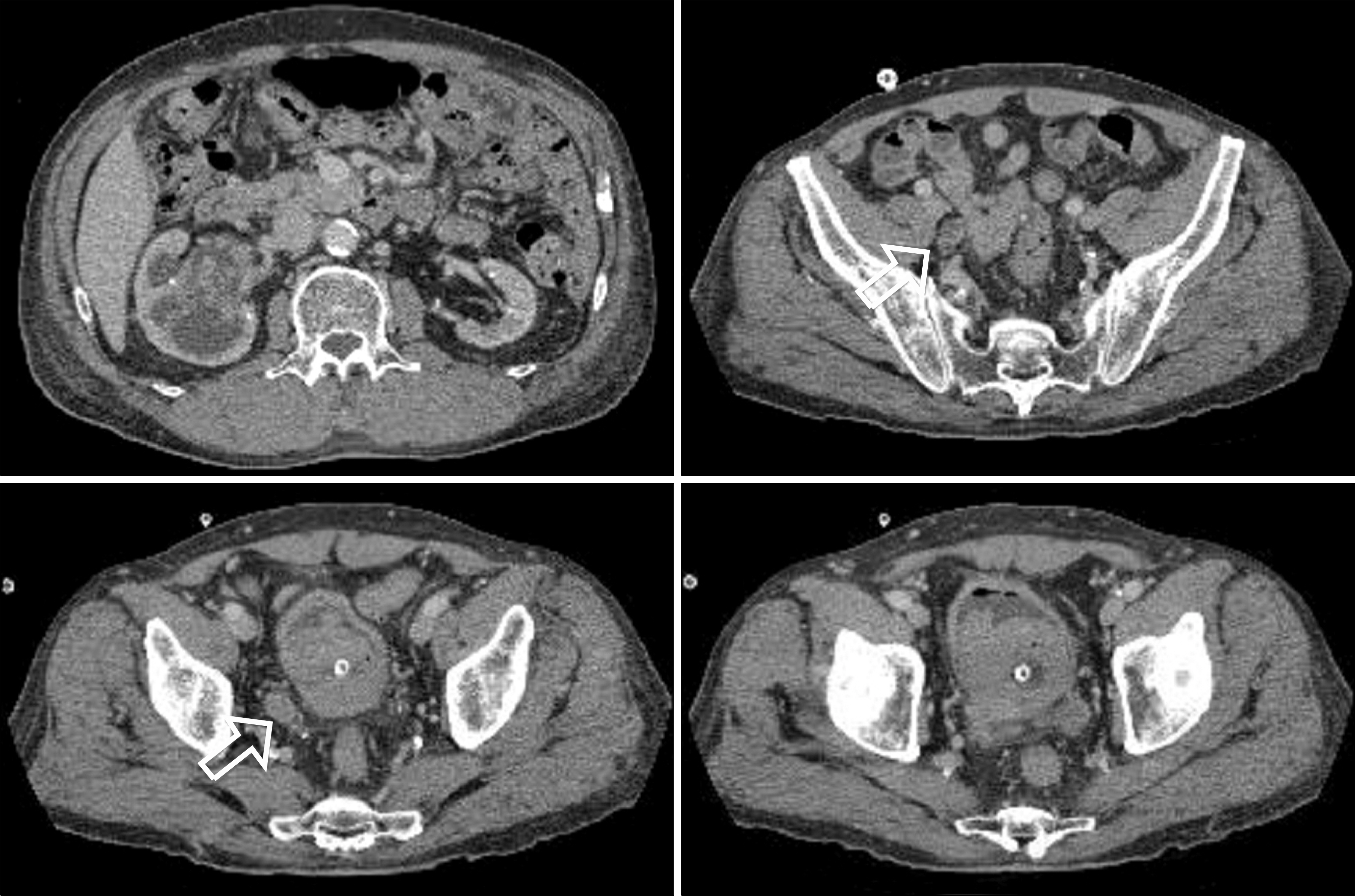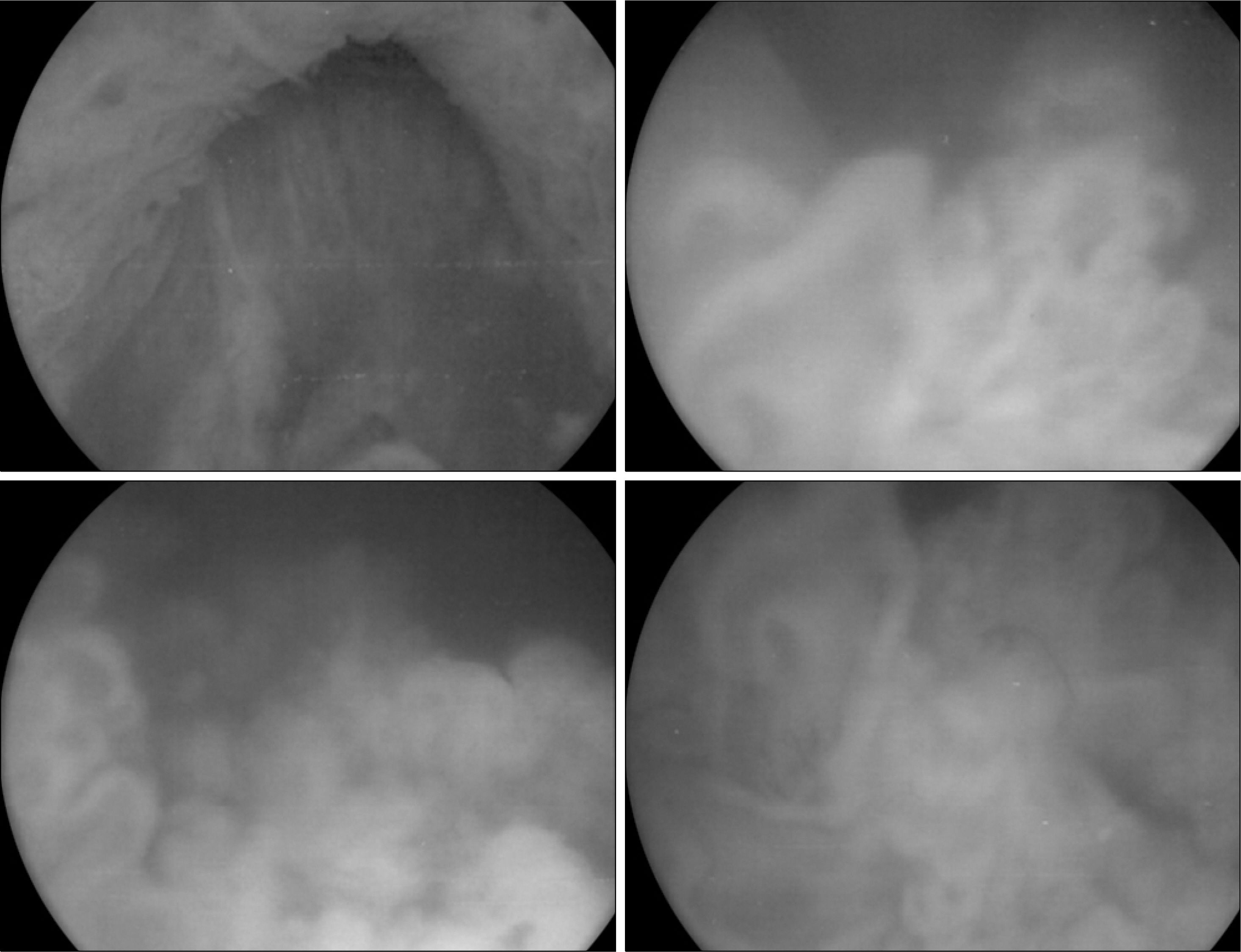Korean J Urol.
2008 Nov;49(11):1046-1050. 10.4111/kju.2008.49.11.1046.
Bilateral Nephroureterectomy with Radical Cystectomy for Urothelial Tumor Involving the Renal Pelvis, Ureter and Bladder in a Patient Receiving Hemodialysis
- Affiliations
-
- 1Department of Urology, College of Medicine, Inje University, Gimhae, Korea. ircho@paik.ac.kr
- 2Department of Pathology, College of Medicine, Inje University, Gimhae, Korea.
- KMID: 1328180
- DOI: http://doi.org/10.4111/kju.2008.49.11.1046
Abstract
- Transitional cell carcinoma such as renal cell carcinoma is the relatively common urinary tract cancer in patients who are on dialysis. A 66-year-old male patient, who had been on maintenance hemodialysis for 5 years, was suffering from gross hematuria. The subsequent image studies revealed multiple masses at the right renal pelvis, the right distal ureter and the trigonal area at the bladder. We performed cystoscopy to evaluate the multiple bladder papillary masses and their blood clots. The patient then underwent bilateral radical nephroureterectomy and radical cystectomy. Histological examination revealed the papillary urothelial carcinoma. Our case may imply that dialysis patients have an increased susceptibility to urological malignancies. Physicians should always raise the possibility of urological malignancy when encountering a dialysis patient with gross hematuria. Because of the high recurrence rate, a more extensive operation and aggressive follow-up protocols should be done for these patients on dialysis.
Keyword
Figure
Reference
-
References
1. Stewart JH, Buccianti G, Agodoa L, Gellert R, McCredie MR, Lowenfels AB, et al. Cancers of the kidney and urinary tract in patients on dialysis for end-stage renal disease: analysis of data from the United States, Europe, and Australia and New Zealand. J Am Soc Nephrol. 2003; 14:197–207.
Article2. Satoh S, Tsuchiya N, Habuchi T, Ishiyama T, Seimo K, Kato T. Renal cell and transitional cell carcinoma in a Japanese population undergoing maintenance dialysis. J Urol. 2005; 174:1749–53.
Article3. Ou JH, Pan CC, Lin JS, Tzai TS, Yang WH, Chang CC, et al. Transitional cell carcinoma in dialysis patients. Eur Urol. 2000; 37:90–4.
Article4. Matas AJ, Simmons RL, Kjellstrand CM, Buselmeier TJ, Najarian JS. Increased incidence of malignancy during chronic renal failure. Lancet. 1975; 1:883–6.
Article5. Wang HB, Hsieh HH, Chen YT, Chiang CY, Cheng YT. The outcome of post-transplant transitional cell carcinoma in 10 renal transplant recipients. Clin Transplant. 2002; 16:410–3.
Article6. Lee KW, Rha KH, Yang SC. Experience of transitional cell carcinoma after renal allograft. Korean J Urol. 2005; 46:241–5.7. Wu CF, Shee JJ, Ho DR, Chen WC, Chen CS. Different treatment strategies for end stage renal disease in patients with transitional cell carcinoma. J Urol. 2004; 171:126–9.
Article8. Wu CF, Chang PL, Chen CS, Chuang CK, Weng HH, Pang ST. The outcome of patients on dialysis with upper urinary tract transitional cell carcinoma. J Urol. 2006; 176:477–81.
Article9. Lee JG, Kim KW, Kwon DD, Oh BR, Ryu SB, Park YI, et al. Differentiation of Infiltrating urothelial tumor of renal pelvis from renal cell carcinoma invading into renal pelvis or calyx. Korean J Urol. 2002; 43:360–6.10. Kim KH, Park JS, Kim CI, Lee KS. Risk factors for the development of bladder transitional cell carcinoma following surgery for transitional cell carcinoma of the upper urinary tract. Korean J Urol. 2005; 46:229–33.
- Full Text Links
- Actions
-
Cited
- CITED
-
- Close
- Share
- Similar articles
-
- Urothelial Tumors
- Urothelial Tumors of the Upper Urinary Tract: Multiplicity and Prognostic Variables
- Risk Factors Leading to Radical Cystectomy in Patients Who Had Undergone Nephroureterectomy
- Renal Pelvis Tumor: A Clinical Review on 4 Cases
- Giant Fibroepithelial Polyp in the Renal Pelvis to the Upper Ureter





